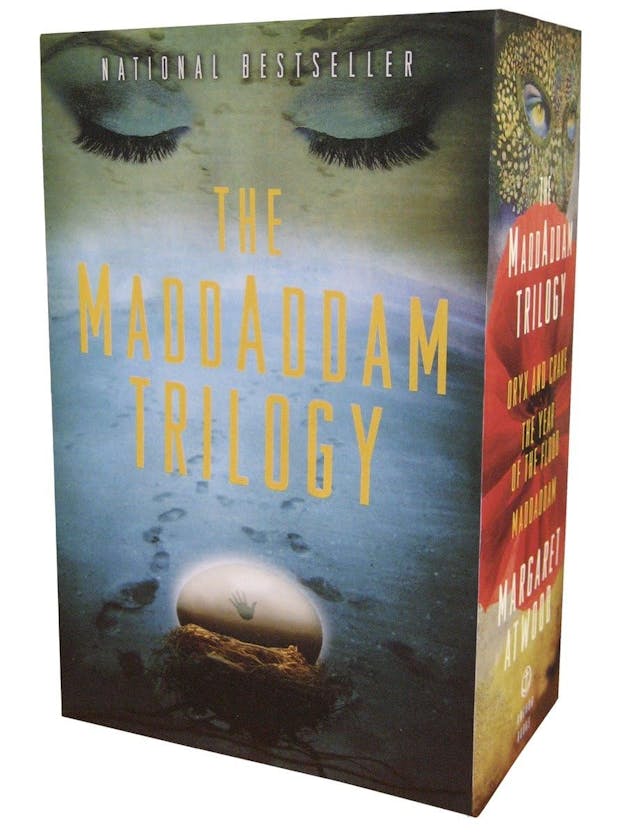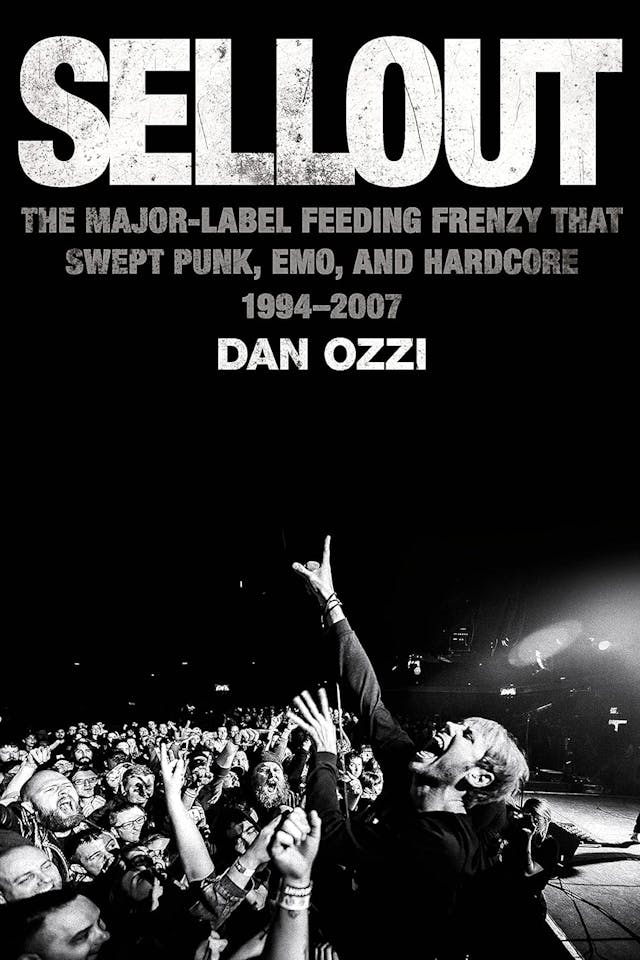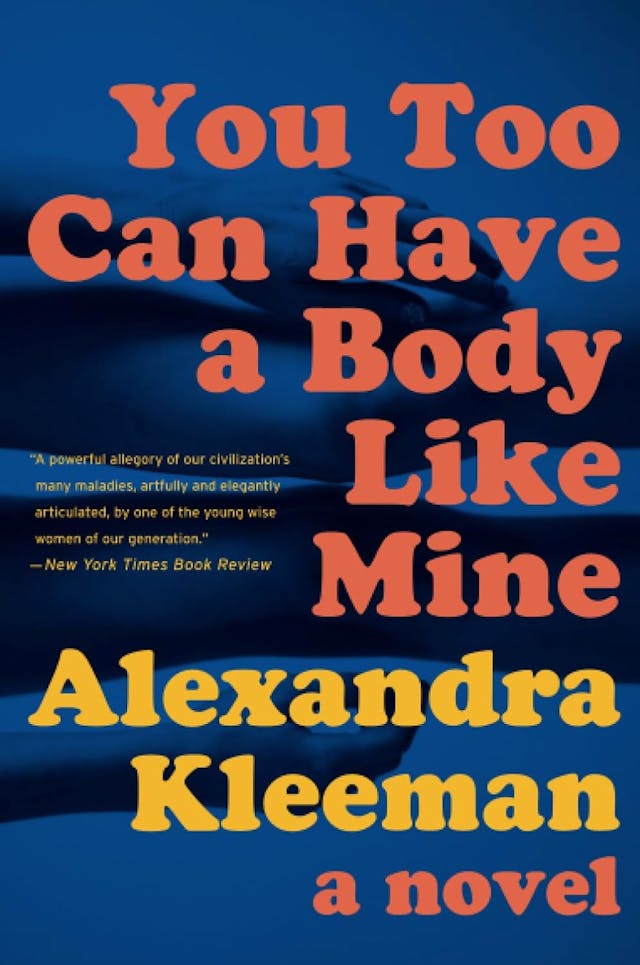Shawn Reynaldo | May 31, 2022
The [Tuesday] Media Diet with Shawn Reynaldo
On Spain, Dischord Records, and Alexandra Kleeman
Recommended Products

Margaret Atwood’s MaddAddam Trilogy, encompassing Oryx and Crake, The Year of the Flood, and MaddAddam, explores a dystopian vision of the future, focusing on themes like climate change, corporate power, wealth disparity, and technology.

Dan Ozzi’s book delves into the major-label era that impacted punk, emo, and hardcore music from 1994 to 2007, examining bands like Green Day, Jawbreaker, and others within the cultural and ethical debates of the time.

A novel by Alexandra Kleeman that explores themes of identity, consumerism, and the body in a surreal, dystopian setting.
We took a day off for Memorial Day, so our MMD drops on a Tuesday. Shawn Reynaldo is a longtime friend of WITI since his days hosting good parties in SF and editing the tastemaking electronic music pub XLR8R. He now writes a great newsletter on electronic music called First Floor. We’re happy to have him on the page today. -Colin (CJN)
Tell us about yourself.
I’m Shawn Reynaldo, and I’m a music journalist based in Barcelona. I’ve lived here for the past seven years, but I’m originally from the Bay Area, though my wife Dania (an Iraqi-born Australian who you may remember from her own Monday Media Diet) likes to remind me that people who didn’t grow up in the United States often don’t know what “Bay Area” means. (When folks here in Spain ask me where I’m from, I usually just say San Francisco.)
Over the past 20+ years, I’ve been involved in numerous facets of the music industry, having spent time running (relatively small) record labels, throwing parties, working in radio (both college and commercial), and somehow convincing people to let me DJ all over the world. However, I’m probably best known as a music journalist and one who specifically focuses on electronic music. I’ve written for outlets like Pitchfork, NPR, SPIN, Resident Advisor, and DJ Mag, was previously the Editor of XLR8R magazine (back when it was more active), and also logged many years working with the Red Bull Music Academy (RIP). These days I’m basically a freelancer—though the sorry economic state of music journalism means that I also take on gigs doing everything from unbylined copywriting to editorial strategy/consulting—and most of my published writing during the past few years has been for First Floor, my own newsletter that’s focused on electronic music and the culture/industry around it.
On a personal level, although most people know me as a “music guy,” I’m actually way more passionate about food and will get particularly animated talking about Mexican food, pasta, and ice cream.
Describe your media diet.
When it comes to regular news, my tastes are pretty standard. I have a digital subscription to the New York Times and also check the Guardian pretty regularly, along with Spanish-language outlets like El País and elDiario.es to keep up with what’s happening here in Spain. All that said, I do often rely on Twitter to keep me apprised of breaking news and whatever the “discourse” is focused on each day.
Most people would never peg me as a sports fan, but I do quietly follow them (basketball and baseball in particular), which leads me to frequent sites like ESPN, The Ringer and Athletics Nation. (The latter is a long-running site/fan community devoted to the Oakland Athletics baseball team.) On the podcast front, I regularly listen to This American Life, Conan O’Brien Needs a Friend, SmartLess, WTF with Marc Maron, 99% Invisible and a few others, mostly while I’m out running in the morning or doing household chores.
Still, it’s music that takes up most of my time, and newsletters like David Turner’s Penny Fractions and Cherie Hu’s Water & Music have become absolutely essential reads, particularly when it comes to emerging financial/technological trends within the music industry. I do subscribe to the Wire, one of the few remaining print titles devoted to experimental and avant-garde sounds of all shapes and sizes. Given that my First Floor newsletter includes a weekly round-up of news, articles, and other bits and bobs from the world of electronic music, I follow about 1000 different artist/label accounts on Bandcamp (mostly to keep up with new release announcements), and I also make a point to keep tabs on an extensive list of music/culture websites, including Pitchfork, Resident Advisor, DJ Mag, Mixmag, Crack, Bandcamp Daily, The Quietus, Beatportal, Ransom Note, Inverted Audio, Stamp the Wax, Dazed, Dummy, The Face, Test Pressing, Attack and 5 Magazine. Are they all excellent all of the time, or even some of the time? Absolutely not, but staying current requires being thorough, and it’s difficult to know exactly where the next great piece of writing will pop up next.
What’s the last great book you read?
“Great” is a tricky word, but I’ve always had a taste for dystopian fiction, and thoroughly enjoyed reading Margaret Atwood’s MaddAddam trilogy (Oryx and Crake, The Year of the Flood, MaddAddam) during the past year. Although these books aren’t as acclaimed as The Handmaid’s Tale (and are admittedly a bit sillier), they were written more recently, and present a dystopian vision of the future that smartly taps into current anxieties about climate change, unchecked corporate power, wealth disparity and technology run amok.
What are you reading now?
I’ve just started Dan Ozzi’s Sellout, which chronicles “the major-label feeding frenzy that swept punk, emo and hardcore” between 1994 and 2007. The book looks at 11 different bands, including Green Day, Jawbreaker, Jimmy Eat World and At the Drive-In, and while revisiting my own past is definitely part of the appeal here (emo was a big part of my musical awakening during the late ’90s and early 2000s, and I still hold up labels like Dischord Records as a sort of DIY ideal), there’s more to it than nostalgia. Nowadays, the idea of “selling out” is often regarded as quaint or flat-out irrelevant, even in “independent” music circles, so it’s interesting to go back and examine a (relatively recent) time when the ethics around artists’ choices about their music—and more specifically, how they chose to market it to the world—was a matter of intense debate.
What’s your reading strategy when you pick up a print copy of your favorite publication?
I like to sit down and consume it all in one sitting, although I’m admittedly something of a skimmer. I usually go front to back, and have a soft spot for introductory letters from the editor, but I’ll often skip the table of contents. Instead, I’ll just start flipping through the pages and see what catches my eye, whether it’s a byline I recognize, an artist/topic I’m interested in or just an intriguing headline.
Who should everyone be reading that they’re not?
Alexandra Kleeman isn’t exactly unknown, but she’s a brilliant writer and novelist whose prose nicely captures the absurdity of living in what feels like increasingly unhinged times. Although her books You Too Can Have a Body Like Mine and last year’s Something New Under the Sun have gotten the most attention—the latter has been celebrated as a highlight of the burgeoning “cli-fi” (i.e. climate fiction) genre—she’s also investigated the pseudoscience behind prescribing bed rest for pregnant women, reported from the Twin Peaks Festival, profiled numerous actors, directors and musicians and penned a number of quietly unnerving short stories. In a word, she’s versatile, but if there’s one philosophical throughline, it’s her ability to highlight how humans will often blithely accept the creeping influence of even the most existential dangers.
Elsewhere, there are of course a number of music writers who I think are worthy of readers’ attention. (In today’s fractured music media landscape, following specific journalists is often a better bet than relying on specific outlets.) Philip Sherburne has (deservedly) long been the gold standard for electronic music writing, and Chal Ravens deserves a similar level of reverence, as her descriptive skills consistently make even the headiest music feel vibrant and alive. Gabriel Szatan is the rare music journalist with a big sense of humor, and his (excellent) prose always reflects just how much fun he’s having.
The aforementioned David Turner and Cherie Hu are doing essential work on behind-the-scenes industry machinations, as are Marc Hogan and Declan McGlynn (although the latter focuses more specifically on electronic music), and then there’s Liz Pelly, hands down the top writer on all things streaming (and how it’s completely warped the music world). Mat Dryhurst and Holly Herndon aren’t technically journalists, but their Interdependence podcast provides vital (and refreshingly optimistic) dispatches from the bleeding edge of music, technology and culture. Speaking of podcasts, rave lifer Vivian Host (who’s also an incredible writer) regularly excavates untold bits of electronic music history on Rave to the Grave, while those seeking a window into the current electronic music landscape should definitely check Jaša Bužinel’s monthly Hyperspecific columns. Elsewhere, Cat Zhang has practically created her own genre while digging into the TikTok landscape and demystifying what exactly Gen Z is up to, and Isabelia Herrera has done similarity groundbreaking (not to mention frequently intensely personal) work while examining the musical exploits of Latin America, the Caribbean and the larger Latin diaspora. Jeremy Larson doesn’t write that often these days—being the Reviews Editor at Pitchfork is a demanding gig—but when he does publish something, it’s always a must-read affair, whether he’s trashing Greta Van Fleet or coming to grips with his own streaming addiction.
I’m probably forgetting some people—my apologies to those I’ve missed—but anyone with an interest in the craft/field of music journalism should also check Todd Burns’ Music Journalism Insider newsletter, which features interviews with writers and editors from across the industry, links to great work and more.
What is the best non-famous app you love on your phone?
In all honesty, none of my favorite apps are all that obscure, but my love for the New York Times app runs pretty deep, to a point where I’ll even check it while I’m out at the club. This is probably a clear sign that I’m getting too old to be raving anymore, but if you ever spot me at the back of the dancefloor, standing alone and looking at my phone, it’s far more likely that I’m catching up on international news than scrolling through social media.
Plane or train?
As a native Californian who started driving at 16 and spent most of my life relying on cars to get around, I have to say that it’s a real privilege to now live a carless life in Europe and enjoy the abundance of trains. Being able to easily hop a train and quickly head to Sitges or somewhere on the Costa Brava is such a luxury, and if something is just a few hours’ away (or less), trains are a fantastic way to go. That being said, when it comes to long-distance (or even medium-distance) travel, I’m a plane guy, simply because it’s faster.
What is one place everyone should visit?
When it comes to travel, my evaluation of a place often boils down to one question: “How many delicious things can I stuff in my face while I’m there?” By that criteria, I’m strongly tempted to say Mexico City (which is just as incredible as everyone says it is), but I’m going to go with Sicily instead. Italy is obviously one of the biggest tourist destinations on the planet, but Sicily has its own distinct vibe. An island that’s closer to Africa than it is the bulk of Europe, the region is less polished and more chaotic than many of its more northern counterparts, but Sicily is also home to a uniquely hybridized culture, having been ruled at different times by Greeks, Romans, Normans, Arabs, the Spanish and others, which helps explain its unique dialect and cuisine. (The latter is frequently out of this world, particularly if you like pistachio pesto, eggplant, gelato, cannolis or starting your day with a breakfast of brioche and granita.) There’s plenty to see as well, whether you’re looking for a Mediterranean beach getaway, ancient ruins, an active volcano (i.e. Mount Etna) or the windy little streets of cities founded during the Middle Ages.
Tell us the story of a rabbit hole you fell deep into.
I recently did a deep dive into Bunkka, a pretty awful album that Paul Oakenfold released in 2002. The major-label debut from an artist who was arguably the biggest DJ in the world at the time, the LP itself—which included a head-scratching list of guest appearances by Perry Farrell, Shifty Shellshock (of nu-metal outfit Crazytown), Ice Cube, Nelly Furtado and (not kidding) Hunter S. Thompson—is probably best forgotten, but it also represents the last gasp of the “electronica” boom that took place in the United States during the late ’90s and early 2000s. American audiences have long had a confused relationship with electronic music, and while the “electronica” era was responsible for introducing seminal acts like Daft Punk, The Prodigy and the Chemical Brothers into the US pop lexicon, the way that the music was marketed (primarily to white, suburban “alternative” listeners who’d come of age listening to grunge, punk and the Beastie Boys) represented a moment of profound cultural erasure. Genres like house, techno and electro had been invented by Black artists in places like Detroit and Chicago more than a decade prior, but the American music industry largely ignored that fact, instead opting to push the re-branded “electronica” as something new from Europe. More than two decades later, that idea still haunts electronic music, and while that certainly can’t all be blamed on Paul Oakenfold, Bunkka ultimately was a sort of inflection point. The album arrived with all sorts of hype and expectations, and in the wake of its failure, the mainstream American music industry basically gave up on electronic music—at least until the EDM boom kicked in nearly a decade later. (That, of course, gave birth to another, even larger wave of historical erasure and cultural misconceptions around electronic music. History sadly does tend to repeat itself.)
On a less serious note, I’ve also been heavily researching cookware lately, as I’ve reached the age where I want to buy a “forever” set of pots and pans. I’m pretty certain that stainless steel is the way to go—we already have a cast-iron skillet and dutch oven—but selecting the right brand is tough. If any chefs (professional or amateur) are reading this, I’m open to suggestions. (SR)
—
WITI x McKinsey:
An ongoing partnership where we highlight interesting McKinsey research, writing, and data.
Marketing in the metaverse. Although widespread adoption of the metaverse may take some time, leading brands are already rewriting the rules of marketing. Here’s how marketers and companies can start experimenting and exploring what the metaverse can offer.
—
Thanks for reading,
Noah (NRB) & Colin (CJN) & Shawn (SR)
—
Why is this interesting? is a daily email from Noah Brier & Colin Nagy (and friends!) about interesting things. If you’ve enjoyed this edition, please consider forwarding it to a friend. If you’re reading it for the first time, consider subscribing (it’s free!).

